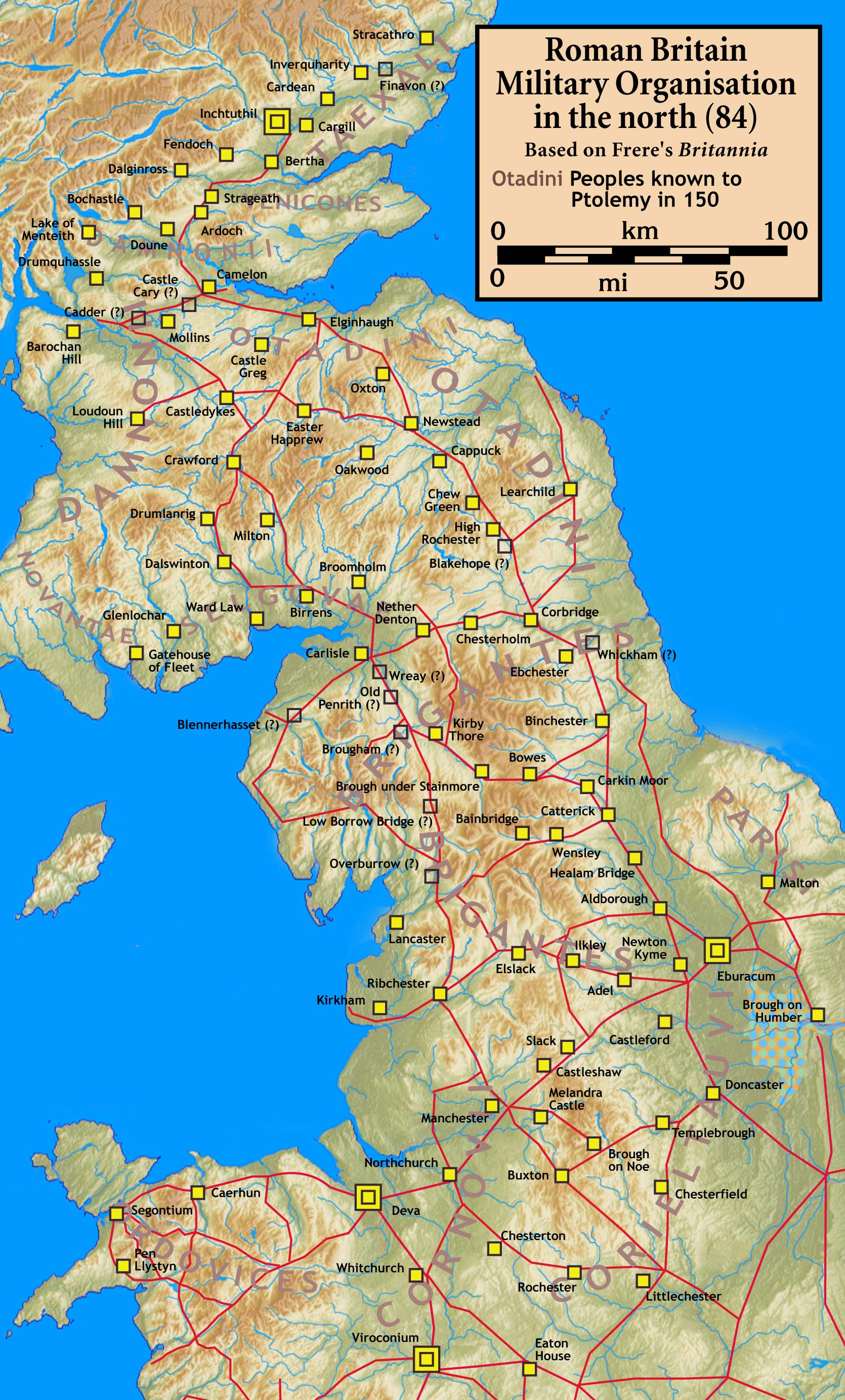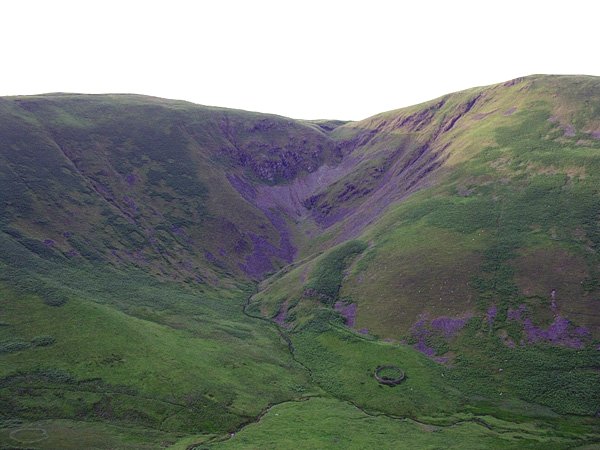|
Blatobulgium
Blatobulgium was a Roman fort, located at the modern-day site known as Birrens, in Dumfriesshire, Scotland. Name Blatobulgium is recorded in the Antonine Itinerary. The name derives from the Brittonic roots ''*blāto-'' 'bloom, blossom' or ''*blāto-'' (from earlier ''*mlāto-''), 'flour' and ''*bolgo-'', 'bag, bulge'. The name may mean 'flowery hillock' or 'flowery hollow'. However, as there are granaries at the fort, Blatobulgium may be a nickname meaning 'Flour Sacks'. History The fort formed the northern terminus of the Roman-era Watling Street (using an extended definition of this road), or more simply Route 2 of the Antonine Itinerary. It was located in the territory of the Selgovae. Birrens was first occupied in the Flavian period from AD 79 onwards, when its internal buildings were presumably of timber. Under Hadrian, soon after AD 122, a new fort was constructed whose central buildings were probably of stone. However the visible fort and its internal buildings date f ... [...More Info...] [...Related Items...] OR: [Wikipedia] [Google] [Baidu] |
Selgovae
The Selgovae (Common Brittonic: *''Selgowī'') were a Celtic tribe of the late 2nd century AD who lived in what is now the Stewartry of Kirkcudbright and Dumfriesshire, on the southern coast of Scotland. They are mentioned briefly in Ptolemy's ''Geography'', and there is no other historical record of them. Their cultural and ethnic affinity is commonly assumed to have been Brittonic. Assertions that the Solway Firth preserves the name of the Selgovae are without foundation. 'Solway' is Anglo-Saxon from the thirteenth century (''sol'' = 'mud', ''wæth'' = 'ford'), and this was the name of the main crossing at Eskmouth at that time. The firth has been known by various names in the past, and this one happened to be the survivor. The historical record Ptolemy The sole record of the Selgovae and their towns is their mention by Ptolemy in c. AD 150. Their name appears in the 8th century ''Ravenna Cosmography'' as 'Segloes', but the document here is taken to be an imperfect copy ... [...More Info...] [...Related Items...] OR: [Wikipedia] [Google] [Baidu] |
Watling Street
Watling Street is a historic route in England that crosses the River Thames at London and which was used in Classical Antiquity, Late Antiquity, and throughout the Middle Ages. It was used by the ancient Britons and paved as one of the main Roman roads in Britannia (Roman-governed Great Britain during the Roman Empire). The route linked Dover and London in the southeast, and continued northwest via St Albans to Wroxeter. The line of the road was later the southwestern border of the Danelaw with Wessex and Mercia, and Watling Street was numbered as one of the major highways of medieval England. First used by the ancient Britons, mainly between the areas of modern Canterbury and using a natural ford near Westminster, the road was later paved by the Romans. It connected the ports of Dubris (Dover), Rutupiae (Richborough Castle), Lemanis (Lympne), and Regulbium (Reculver) in Kent to the Roman bridge over the Thames at Londinium (London). The route continued northwest through ... [...More Info...] [...Related Items...] OR: [Wikipedia] [Google] [Baidu] |
History Of Dumfriesshire
Dumfriesshire or the County of Dumfries or Shire of Dumfries (''Siorrachd Dhùn Phris'' in Gaelic) is a historic county and registration county in southern Scotland. The Dumfries lieutenancy area covers a similar area to the historic county. In terms of historic counties it borders Kirkcudbrightshire to the west, Ayrshire to the north-west, Lanarkshire, Peeblesshire and Selkirkshire to the north, and Roxburghshire to the east. To the south is the coast of the Solway Firth, and the English county of Cumberland. Dumfriesshire has three traditional subdivisions, based on the three main valleys in the county: Annandale, Eskdale and Nithsdale. These had been independent provinces in medieval times but were gradually superseded as administrative areas by the area controlled by the sheriff of Dumfries, or Dumfriesshire. A Dumfriesshire County Council existed from 1890 until 1975. Since 1975, the area of the historic county has formed part of the Dumfries and Galloway council area f ... [...More Info...] [...Related Items...] OR: [Wikipedia] [Google] [Baidu] |
Dumfriesshire
Dumfriesshire or the County of Dumfries or Shire of Dumfries (''Siorrachd Dhùn Phris'' in Gaelic) is a historic county and registration county in southern Scotland. The Dumfries lieutenancy area covers a similar area to the historic county. In terms of historic counties it borders Kirkcudbrightshire to the west, Ayrshire to the north-west, Lanarkshire, Peeblesshire and Selkirkshire to the north, and Roxburghshire to the east. To the south is the coast of the Solway Firth, and the English county of Cumberland. Dumfriesshire has three traditional subdivisions, based on the three main valleys in the county: Annandale, Eskdale and Nithsdale. These had been independent provinces in medieval times but were gradually superseded as administrative areas by the area controlled by the sheriff of Dumfries, or Dumfriesshire. A Dumfriesshire County Council existed from 1890 until 1975. Since 1975, the area of the historic county has formed part of the Dumfries and Galloway council ... [...More Info...] [...Related Items...] OR: [Wikipedia] [Google] [Baidu] |
Ricagambeda
Ricagambeda was a Celtic goddess worshipped in Roman Britain. She is attested in a single inscription, ''RIB'' 2107, on an altar stone found at Birrens (the Roman Blatobulgium) in what is now Dumfries and Galloway, Scotland. According to the inscription, the altar was raised by men from Vella serving with the Second Cohort of Tungrians in fulfillment of a vow to the goddess. Xavier Delamarre has suggested that her name may be related to the Gaulish word *''ricā'', meaning ''‘ sillon’'' (‘furrow A plough or plow ( US; both ) is a farm tool for loosening or turning the soil before sowing seed or planting. Ploughs were traditionally drawn by oxen and horses, but in modern farms are drawn by tractors. A plough may have a wooden, iron or ...’).Xavier Delamarre (2003), ''Dictionnaire de la langue gauloise'', p.256. References Goddesses of the ancient Britons {{Celt-myth-stub ... [...More Info...] [...Related Items...] OR: [Wikipedia] [Google] [Baidu] |
Flour Sacks
A flour sack or flour bag is a bag or sack for flour. Large bulk bags as well as smaller consumer sizes are available. Description A flour sack or flour bag is a bag or sack for flour. Sacks range in size and material. Package types Bulk packaging Flour is often shipped from the miller to bakeries, institutions, and other bulk uses. Sizes range from 10 kg to 100 kg. One traditional construction was cheap cotton bags. These printed cotton bags were sometimes viewed as collectables; other times the flour sack fabric was repurposed into a variety of household items. Current practices are to use multi-wall paper sacks. Some include a layer of plastic film for barrier properties and insect control. Woven polypropylene bags are also used for high strength; at least one variety ( Purdue Improved Crop Storage bags) also includes inner plastic bags. Consumer packaging Consumer packages are often bags or sacks constructed of paper. Plastic films are also used, sometimes with ... [...More Info...] [...Related Items...] OR: [Wikipedia] [Google] [Baidu] |
Roman
Roman or Romans most often refers to: *Rome, the capital city of Italy *Ancient Rome, Roman civilization from 8th century BC to 5th century AD *Roman people, the people of ancient Rome *''Epistle to the Romans'', shortened to ''Romans'', a letter in the New Testament of the Christian Bible Roman or Romans may also refer to: Arts and entertainment Music * Romans (band), a Japanese pop group * ''Roman'' (album), by Sound Horizon, 2006 * ''Roman'' (EP), by Teen Top, 2011 *" Roman (My Dear Boy)", a 2004 single by Morning Musume Film and television * Film Roman, an American animation studio * ''Roman'' (film), a 2006 American suspense-horror film * ''Romans'' (2013 film), an Indian Malayalam comedy film * ''Romans'' (2017 film), a British drama film * ''The Romans'' (''Doctor Who''), a serial in British TV series People *Roman (given name), a given name, including a list of people and fictional characters *Roman (surname), including a list of people named Roman or Romans *Ῥωμα ... [...More Info...] [...Related Items...] OR: [Wikipedia] [Google] [Baidu] |
Flavian Dynasty
The Flavian dynasty ruled the Roman Empire between AD 69 and 96, encompassing the reigns of Vespasian (69–79), and his two sons Titus (79–81) and Domitian (81–96). The Flavians rose to power during the civil war of 69, known as the Year of the Four Emperors. After Galba and Otho died in quick succession, Vitellius became emperor in mid 69. His claim to the throne was quickly challenged by Roman legion, legions stationed in the Eastern provinces, who declared their commander Vespasian emperor in his place. The Second Battle of Bedriacum tilted the balance decisively in favour of the Flavian forces, who entered Rome on 20 December. The following day, the Roman Senate officially declared Vespasian emperor of the Roman Empire, thus commencing the Flavian dynasty. Although the dynasty proved to be short-lived, several significant historic, economic and military events took place during their reign. The reign of Titus was struck by multiple natural disasters, the most ... [...More Info...] [...Related Items...] OR: [Wikipedia] [Google] [Baidu] |
At The Western Edge Of Birrens (Blatobulgium) Roman Fort - Geograph
AT or at may refer to: Geography Austria * Austria (ISO 2-letter country code) * .at, Internet country code top-level domain United States * Atchison County, Kansas (county code) * The Appalachian Trail (A.T.), a 2,180+ mile long mountainous trail in the Eastern United States Elsewhere * Anguilla (World Meteorological Organization country code) * Ashmore and Cartier Islands (FIPS 10-4 territory code, and obsolete NATO country code) * At, Bihar, village in Aurangabad district of Bihar, India * Province of Asti, Italy (ISO 3166-2:IT code) Science and technology Computing * @ (or "at sign"), the punctuation symbol now typically used in e-mail addresses and tweets) * at (command), used to schedule tasks or other commands to be performed or run at a certain time * IBM Personal Computer/AT ** AT (form factor) for motherboards and computer cases ** AT connector, a five-pin DIN connector for a keyboard * The Hayes command set for computer modems (each command begins with th ... [...More Info...] [...Related Items...] OR: [Wikipedia] [Google] [Baidu] |
Roman Empire
The Roman Empire ( la, Imperium Romanum ; grc-gre, Βασιλεία τῶν Ῥωμαίων, Basileía tôn Rhōmaíōn) was the post-Republican period of ancient Rome. As a polity, it included large territorial holdings around the Mediterranean Sea in Europe, North Africa, and Western Asia, and was ruled by emperors. From the accession of Caesar Augustus as the first Roman emperor to the military anarchy of the 3rd century, it was a Principate with Italia as the metropole of its provinces and the city of Rome as its sole capital. The Empire was later ruled by multiple emperors who shared control over the Western Roman Empire and the Eastern Roman Empire. The city of Rome remained the nominal capital of both parts until AD 476 when the imperial insignia were sent to Constantinople following the capture of the Western capital of Ravenna by the Germanic barbarians. The adoption of Christianity as the state church of the Roman Empire in AD 380 and the fall of the Western ... [...More Info...] [...Related Items...] OR: [Wikipedia] [Google] [Baidu] |
Ancient Rome
In modern historiography, ancient Rome refers to Roman civilisation from the founding of the city of Rome in the 8th century BC to the collapse of the Western Roman Empire in the 5th century AD. It encompasses the Roman Kingdom (753–509 BC), Roman Republic (509–27 BC) and Roman Empire (27 BC–476 AD) until the fall of the western empire. Ancient Rome began as an Italic settlement, traditionally dated to 753 BC, beside the River Tiber in the Italian Peninsula. The settlement grew into the city and polity of Rome, and came to control its neighbours through a combination of treaties and military strength. It eventually dominated the Italian Peninsula, assimilated the Greek culture of southern Italy ( Magna Grecia) and the Etruscan culture and acquired an Empire that took in much of Europe and the lands and peoples surrounding the Mediterranean Sea. It was among the largest empires in the ancient world, with an estimated 50 to 90 million inhabitants, roughly 20% of t ... [...More Info...] [...Related Items...] OR: [Wikipedia] [Google] [Baidu] |








